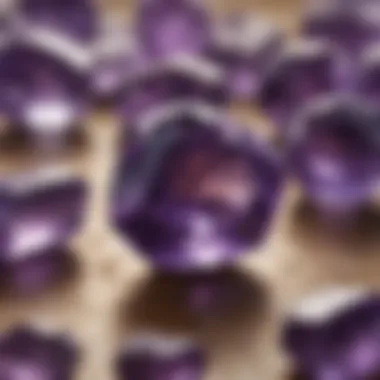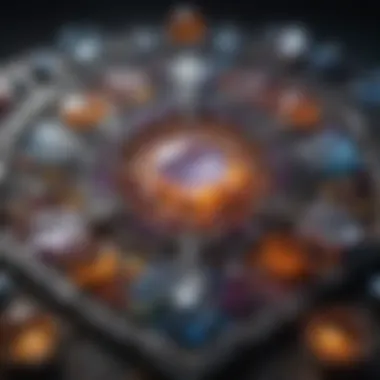Explore the Best Crystals for Alleviating Anxiety


Intro
Anxiety is a common experience, affecting many individuals across various contexts. As people seek methods for managing anxiety, crystals have gained popularity for their purported benefits. This article aims to provide insight into the best crystals for anxiety, focusing on their various properties, uses, and cultural significance while discussing the scientific perspectives surrounding them.
Gemstone Overview
Definition and Characteristics
Crystals are solid materials with a highly ordered atomic structure. They often exhibit symmetry and a defined geometric shape. The characteristics of gemstones can include color, clarity, cut, and carat weight. Each crystal contains unique energies and vibrations, which some believe can influence emotional states.
Classification of Gemstones
Gemstones can be classified into two main categories: precious and semi-precious. Precious gemstones, such as diamonds, rubies, sapphires, and emeralds, are rarer and often more valuable. Semi-precious gemstones, like amethyst, aquamarine, and garnet, are more abundant and tend to be more accessible to the general public.
The classification of gemstones can also extend to their origins, including natural, synthetic, and treated varieties. Natural gemstones are formed through geological processes, while synthetic stones are created in laboratories. Treatment processes may enhance a gemstone's appearance but could impact its value.
Properties of Gemstones
Physical Properties
The physical properties of gemstones are vital in understanding their potential effectiveness in anxiety relief. These properties include hardness, lustre, and specific gravity. For instance, quartz has a hardness of 7 on the Mohs scale, making it quite durable for daily wear or use. Typically, the more durable a stone, the better it can withstand the stresses of daily life.
Chemical Properties
Chemical properties also play a role in gemstone applications. The composition and structure of a gemstone can determine its behavior and effectiveness. For example, citrine is composed of silicon dioxide and exhibits a yellow hue due to iron impurities. This unique chemical composition may contribute to its potential effects on emotional well-being.
"Understanding the properties of gemstones allows enthusiasts to make informed choices regarding which stones may be suitable for their needs."
The relevance of these properties lies in their connection to holistic practices and alternative therapies. Many believe specific crystals can support emotional balance, reduce tension, and promote a sense of calm. Thus, an informed approach to selecting suitable gemstones is crucial for individuals seeking relief from anxiety.
Understanding Anxiety
Anxiety is a complex emotional experience that affects many individuals in various forms. Understanding anxiety is crucial, especially when exploring remedies like crystals. It is important to recognize the mechanisms of anxiety, since they serve as a foundation for assessing effective solutions.
Anxiety is not merely a feeling of unease but can be part of broader mental health conditions. Grasping its definition and implications assists individuals in identifying their emotions accurately. This knowledge fosters an environment where holistic practices, like using crystals, are understood not as replacements for professional help but as complementary tools.
Moreover, awareness of common causes allows us to consider how external factors may influence anxiety levels. Understanding triggers may facilitate more informed decisions about which crystals to use for support. A deeper comprehension of anxiety symptoms forms the basis for recognizing its impact on daily life. This layer of understanding can guide readers towards suitable crystals that might bring a sense of calm and balance.
The Role of Crystals in Healing
The concept of using crystals for healing has gained significant traction in recent years, as more individuals seek alternative solutions to manage stress and anxiety. Unlike conventional medicine, which often focuses on pharmacological treatments, crystal healing offers an approach that is deeply rooted in natural processes and holistic practices. This section will delve into the various aspects of crystal healing, emphasizing its historical significance, metaphysical claims, and scientific insights.
Historical Perspective
Crystals have been utilized for healing purposes since antiquity. Ancient civilizations, such as the Egyptians and Greeks, believed in the powerful attributes of these natural stones. They were often incorporated into rituals, tools, and jewelry designed to promote balance and health. For example, the Egyptians placed lapis lazuli in tombs, believing it held protective qualities in the afterlife.
In different cultures, jade was esteemed for its healing capabilities, while amethyst was prized for mental clarity. Such historical uses laid the groundwork for contemporary practices, reflecting a long-standing reverence for the Earth’s treasures. Even in modern times, many practitioners still draw upon these ancient beliefs, viewing crystals as allies in the pursuit of emotional and physical well-being.
Metaphysical Properties of Crystals
The metaphysical properties attributed to crystals form the core of their appeal in anxiety management. Proponents argue that each crystal carries a unique energy signature, influencing the mind and body in various ways. For instance, amethyst is often associated with tranquility and stress relief, making it a popular choice among those seeking to alleviate anxiety.
Crystals like rose quartz are linked to self-love and compassion, believed to ease emotional wounds. Lepidolite, rich in lithium, is often cited for its calming effects. Each crystal's use may vary according to individual needs or situations, inviting users to create a personalized approach to their healing journey.


"Crystals function as conduits for energy, allowing users to tap into their healing potentials."
Scientific Insights on Crystal Healing
The scientific community has approached crystal healing with a degree of skepticism. Limited empirical evidence exists to support the healing claims made by enthusiasts. While some studies suggest that the psychological effects of using crystals—like the placebo effect—can lead to relief from anxiety symptoms, the physical properties of crystals are often dismissed as having minimal impact on health.
Despite this skepticism, exploring the empirical side of crystal healing could provide valuable insights. Research into the therapeutic value of color therapy and vibrational healing show parallels to how individuals might respond to crystal energies. The act of interacting with and focusing on crystals could offer a meditative experience, potentially contributing to lower stress and anxiety levels. Ultimately, while scientific validation remains scarce, many find the practice worthwhile, leading to improved emotional well-being.
Crystals Specifically for Anxiety
The topic of crystals specifically for anxiety addresses the intersection between mental health and holistic practices. Crystals are often seen as tools for emotional balance and support. By understanding their specific properties and how they interact with human energy, one can better utilize these natural resources to combat anxiety.
While scientific validation may still be growing, many people report positive experiences when incorporating crystals into their lives. The importance lies not only in the potential benefits but also in the personal exploration that comes with selecting the right crystal.
Amethyst
Properties and Benefits
Amethyst is known for its calming qualities. It is often cited as a go-to choice for those experiencing anxiety due to its ability to promote tranquility and balance. The unique feature of amethyst is its high vibrational energy. It is believed to alleviate stress and help one feel grounded.
Its soothing properties make it popular among gemstone enthusiasts. This crystal is often associated with clarity of mind and emotional stability. However, some may find that it has a very subtle effect, not always producing immediate results.
How to Use Amethyst
Amethyst can be used in various ways. One common method is to meditate with the crystal in hand. Holding it during moments of stress may enhance feelings of calm. Its key characteristic as a sleep aid makes it a popular choice for those who suffer from restless nights due to anxiety.
Also, placing amethyst under a pillow can promote restful sleep, but it might be too stimulating for some users. Thus, experimenting with different approaches is advised.
Rose Quartz
Properties and Benefits
Rose quartz is often referred to as the "love stone." It is widely recognized for its emotional healing properties. This crystal is primarily associated with love, compassion, and peace. Those dealing with anxiety may appreciate its gentle energy. The key characteristic of rose quartz lies in its ability to foster self-love and open the heart. It helps release negative emotions and provides emotional support. However, users should note that its effects may differ from person to person, with some needing time to adjust.
How to Use Rose Quartz
Using rose quartz can be as simple as carrying it in your pocket or wearing it as jewelry. Another method is to place it in your living space to promote a calming environment. One unique feature of rose quartz is its pink color, which is visually soothing and enhances its calming presence.
Users might find that having it close by during stressful times provides comfort, but like all crystals, personal resonance plays a role.
Lepidolite
Properties and Benefits
Lepidolite is known for containing lithium, a natural substance used in some mental health medications. This crystal is claimed to be effective in reducing anxiety and stress. Its properties include stabilizing emotions and helping to transition through difficult times. One key characteristic of lepidolite is its purifying nature; it can help calm an anxious mind and promote emotional well-being. Some may find its effects quite pronounced while others might see more subtle shifts in their mood.
How to Use Lepidolite
Lepidolite can be placed in environments where one seeks calm, such as home or work. It can also be used during meditative practices. Notably, people often find comfort holding it during moments of panic.
However, there are reports of users feeling overwhelmed by its energy. It is wise to approach lepidolite cautiously if you're sensitive to energetic shifts.
Blue Lace Agate
Properties and Benefits
Blue lace agate is appreciated for its gentle, calming energy. Known for offering peace and clarity, it is beneficial for those struggling with communication-related anxiety. This stone's primary characteristic is its ability to encourage self-expression.
Many find it beneficial for soothing the throat chakra, which facilitates clearer communication. Its soft blue color is also visually calming, enhancing its appeal.
How to Use Blue Lace Agate
Blue lace agate can be worn as jewelry or kept nearby during conversations that provoke anxiety. One unique feature is its use in stress-relief techniques like breathwork, where it serves as a tactile focus. However, some may not immediately feel its effects, especially when in high-stress situations. Engage with it gradually to determine your responsiveness.
Black Tourmaline


Properties and Benefits
Black tourmaline is often called a protective stone. Its grounding properties help create a barrier against negative energies. This makes it valuable for anxiety management, particularly in overwhelming environments. One key characteristic is its ability to absorb electromagnetic stress.
Many people find peace in its presence, as it connects them to the earth. This may lead to a more stabilized emotional state, but it can take time to feel these benefits.
How to Use Black Tourmaline
Black tourmaline can be placed in various locations around the home or carried as a pocket stone. It is particularly effective when used in conjunction with grounding exercises.
One unique feature of black tourmaline is its versatility; it can adapt to various environments, providing protection wherever it is used. Users might need to recharge it frequently, as it is believed to absorb energies that may require cleansing.
Sodalite
Properties and Benefits
Sodalite is known for enhancing logic and rational thought. This makes it ideal for those whose anxiety manifests through overthinking. A key characteristic of sodalite is its ability to foster idealism and creativity while creating a sense of calm. Users often report increased mental clarity as it helps integrate logical thinking with emotional insights. However, it might lead to overwhelming feelings in very sensitive individuals.
How to Use Sodalite
Sodalite can be placed on a desk or in a study area to promote focus. Engaging with it during brainstorming sessions can inspire new ideas. Some prefer wearing it as accessories, keeping it close to benefit from its calming effects. Nonetheless, it may clash with certain personality types, so finding personal harmony with it is essential.
Citrine
Properties and Benefits
Citrine is often associated with positivity and abundance. This crystal is known for its ability to help dispel negative thoughts, making it an appealing option for anxiety relief. Its key characteristic is its energizing nature, often uplifting one’s mood. Citrine is particularly favored for its warmth and encouraging energy. However, some may find its vibrant energy to be slightly overstimulating.
How to Use Citrine
Citrine can be used in daily affirmations or placed in personal spaces to attract positive energy. Many users enjoy wearing it as jewelry, as it serves as a reminder of one's intentions. It can work well in group settings to enhance collective energy. However, it's crucial to test its effects, as its potency varies among individuals.
Choosing the Right Crystal
Choosing the right crystal for anxiety can significantly impact one's overall experience with holistic healing. This section will break down practical elements to consider when selecting a crystal that aligns with individual needs. The benefits of proper selection include enhanced emotional balance, greater ease in managing anxiety, and a more fulfilling connection with the chosen stone. Understanding what to look for and how to assess personal needs is crucial to maximizing the therapeutic effects of crystals.
Assessing Personal Needs
The assessment of personal needs acts as a foundational step in selecting an appropriate crystal. Each person's anxiety triggers differ, and a personalized approach ensures that the chosen crystal effectively addresses specific emotional or psychological concerns. Here are several points to consider while assessing one’s needs:
- Type of Anxiety: Identify the nature of anxiety—whether it is social anxiety, generalized anxiety disorder, or situational anxiety. Different crystals may provide varying benefits depending on the type.
- Emotional State: Evaluate current feelings. For instance, if feeling overwhelmed, a calming stone like amethyst could be beneficial. Conversely, someone needing motivation might benefit from citrine.
- Intuition: Trusting one’s intuition is critical. Often, a crystal will resonate more than others, suggesting a deeper connection. Holding or visualizing different stones can reveal a preference that aligns with personal energy.
By clearly understanding personal needs, one can choose crystals that fit well with their emotional landscape, ultimately enhancing the healing process.
Identifying Authentic Crystals
When seeking crystals for anxiety, authenticity matters. The market features a range of options, and distinguishing real crystals from synthetics or treated stones will ensure the purchase brings the desired benefits. Factors to consider include:
- Source of Purchase: Purchase crystals from reputable dealers or well-reviewed online platforms. Brands with transparency about their sourcing and practices usually offer genuine products.
- Physical Characteristics: Observe the crystal’s appearance. Authentic crystals exhibit unique patterns and imperfections, whereas synthetic stones may look too flawless.
- Energy Testing: Some enthusiasts advocate for energy testing, where one can hold the crystal to feel its vibrations. Authentic stones tend to have a notable energy signature.
"Using true, authentic crystals ensures you harness their full potential to alleviate anxiety, rather than settling for substitutes that may lack effectiveness."
By properly identifying authentic crystals, one can be more confident in their selection, tapping into the true power of these gemstones for anxiety relief.
Incorporating Crystals into Daily Life
Crystals have been used for thousands of years in various cultures as tools for healing and emotional balance. In the context of anxiety, they can serve as meaningful additions to daily practices. Utilizing crystals in everyday life can deepen one's connection to emotional well-being. It provides tangible ways to acknowledge and address anxiety.
Meditation Practices


Meditation with crystals can enhance focus and calmness. Selecting the right crystal involves intuition. A practitioner might choose amethyst for its calming energy or rose quartz for self-love. Holding the crystal during meditation can help center thoughts. Some people find it beneficial to place crystals on their body or nearby.
To meditate effectively, find a quiet space. Sit comfortably and close your eyes. Take deep breaths, inhaling and exhaling slowly. Place the selected crystal in your hand or on your heart. Visualize a calming light emanating from the crystal, enveloping you in tranquility. This connection between mind and crystal often promotes a state of relaxation.
Crystal Grids for Anxiety Relief
Creating a crystal grid is another powerful method for incorporating crystals into daily life. Crystal grids involve arranging multiple crystals in a pattern to amplify their energies. Sodalite and black tourmaline can be great foundations for a grid designed to reduce anxiety. Each crystal's placement can be purposeful, intended to balance energies in a specific space.
To construct a crystal grid, first choose a location. Next, gather your selected crystals. Lay them out in a geometric pattern, paying attention to the flow of energy. Some individuals find that incorporating a center stone, like citrine, can enhance the grid's purpose. When the grid is complete, take a moment to meditate near it, focusing on your intentions. This action may create a calming space in your home.
Carrying and Wearing Crystals
Carrying or wearing crystals is a convenient way to maintain a sense of peace throughout the day. Blue lace agate can be carried in a pocket, providing reminders to breathe and stay calm. Wearing crystals as jewelry allows individuals to keep their energy close. A pendant or bracelet featuring lepidoite can subtly promote emotional balance.
Those who choose to keep crystals on them should be mindful of the size and comfort. Small tumbled stones can easily fit in a wallet or bag. Larger pieces may amplify certain energies but can be cumbersome if worn all day. Setting clear intentions when wearing or carrying crystals can enhance their effectiveness, allowing them to serve as reminders throughout daily experiences.
"The key to effective use of crystals in daily life lies in intention and mindfulness."
Incorporating crystals into daily routines fosters a continual connection to emotional balance and mindfullness, bringing attention to one's feelings and reactions. This practice can gradually lead to a more centered and peaceful state.
Limitations and Considerations
When examining the role of crystals in alleviating anxiety, it is essential to address the limitations and considerations associated with their use. While many individuals report subjective benefits from crystal healing, these experiences can vary widely. Understanding these limitations helps to set realistic expectations and to recognize the role of comprehensive mental health management.
Understanding Limitations of Crystal Healing
Crystals are often regarded as powerful tools for emotional healing. However, it is vital to acknowledge that crystal healing is not a substitute for professional mental health treatment. Crystals may offer comfort or a sense of calm, but they should be part of a broader strategy for managing anxiety.
Research on crystal healing largely falls within anecdotal evidence rather than robust scientific validation. While some individuals swear by their effects, systematic studies often lack. Therefore, it is crucial to approach their use with an open, yet critical, mindset. Consider this:
- Subjective Experience: Many benefits attributed to crystals may stem from placebo effects. The belief in their power can foster a positive mental state.
- Unsupported Claims: There is a significant absence of scientific research directly supporting the efficacy of crystals for anxiety. Be cautious about claims that suggest otherwise.
- Complementary Use: Crystals should complement, not replace, traditional mental health therapies such as cognitive behavioral therapy or medication.
Potential Reactions and Interactions
Another important aspect to consider is the potential for reactions and interactions when using crystals. While physically using crystals is generally safe, several aspects warrant attention:
- Personal Sensitivity: Individuals may have differing sensitivities to certain materials. For instance, some may experience skin irritation from prolonged contact with specific crystals. Pay attention to how your body responds.
- Emotional Overload: Some people might find that certain crystals amplify emotions. For example, a crystal meant to promote calmness can sometimes intensify feelings before achieving that effect. It is vital to remain mindful and observant during their use.
- Interactions with Other Practices: If you are using other holistic practices or treatments, be aware of how crystals may interplay with these. Certain energy modalities may contradict the properties of specific crystals.
Ultimately, while crystals can serve as beneficial tools in managing anxiety, their effectiveness can be hugely personal and varies from one individual to another. Always prioritize a balanced approach that includes holistic practices along with professional guidance when addressing mental health issues.
Final Thoughts
The discussion surrounding anxiety and the role of crystals within this context is multifaceted. The effects of anxiety on individuals can be profound, affecting emotional well-being and overall quality of life. Crystals, often viewed as alternative healing tools, offer an intriguing avenue for exploration. Understanding how to incorporate these gemstones into one's life allows individuals to seek relief and promote a sense of calm.
Encouraging a Balanced Approach to Anxiety Management
Within the realm of anxiety management, it's essential to adopt a balanced perspective. Crystals can potentially enhance emotional stability, but they should not be viewed as a sole solution. Integrating crystal usage with established therapeutic practices, such as cognitive behavioral therapy or mindfulness techniques, can lead to a more effective strategy. This holistic method acknowledges the complexity of anxiety while embracing varied healing modalities.
Key elements to consider may include:
- Personal Preference: Choosing crystals that resonate personally can improve the effectiveness of their use. Select stones that draw a sense of calm when held or worn.
- Understanding Limits: While crystals may have calming properties, their effects can vary from person to person. It is important not to rely solely on them without professional support when needed.
Resources for Further Exploration
For those interested in delving deeper into the topic of crystals and anxiety, several resources may offer valuable insights:
- Wikipedia: A broad collection of articles about minerals and their uses. Link
- Britannica: Offers detailed explanations about various healing methods and holistic practices. Link
- Reddit: The community often shares personal experiences and advice about using crystals for anxiety relief. Link
- Facebook: Join groups dedicated to crystal enthusiasts where members share tips and resources. Link
"Incorporation of crystal healing into everyday life can provide individuals with tools to navigate anxious moments, but it should complement, not replace, traditional treatment methods."
By considering these resources and encouraging a balanced approach, individuals may find a fuller understanding of anxiety management methods. Combining these practices can pave the way for healthier emotional landscapes.



